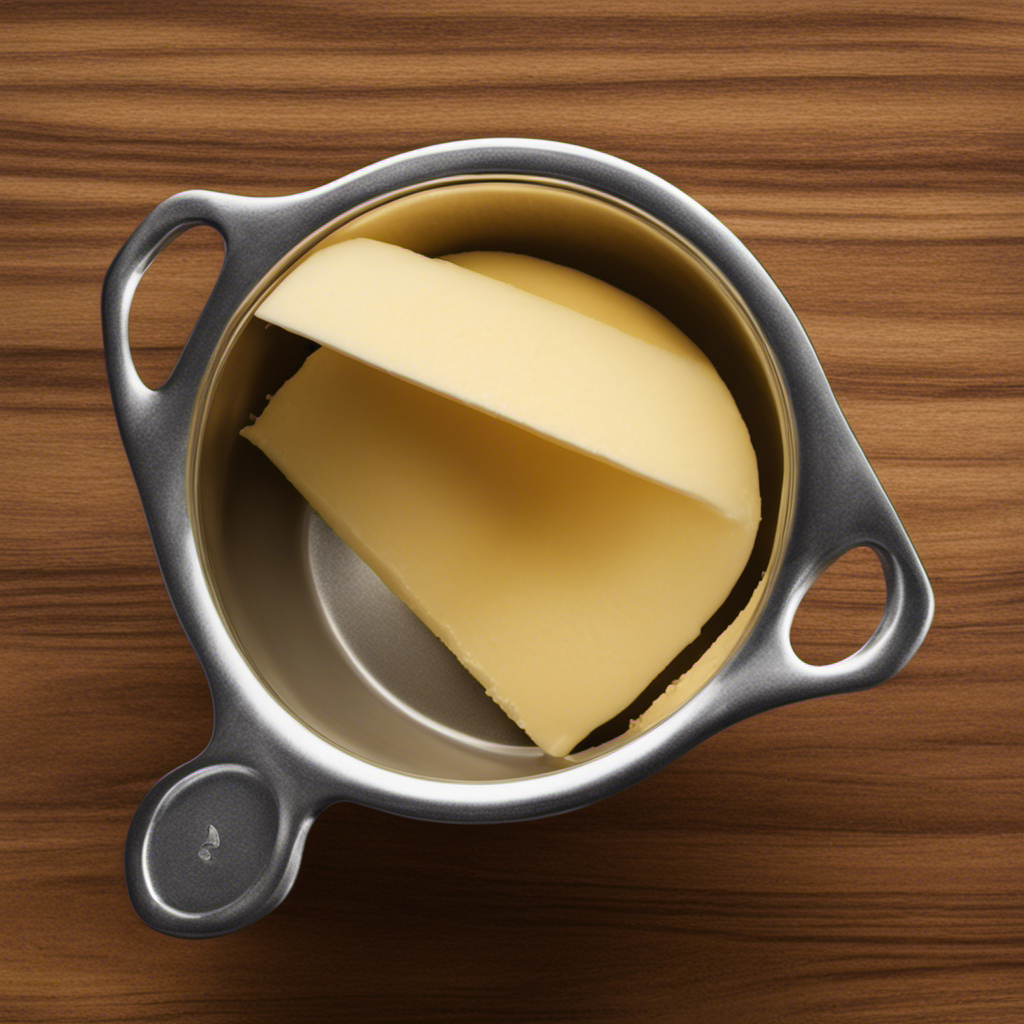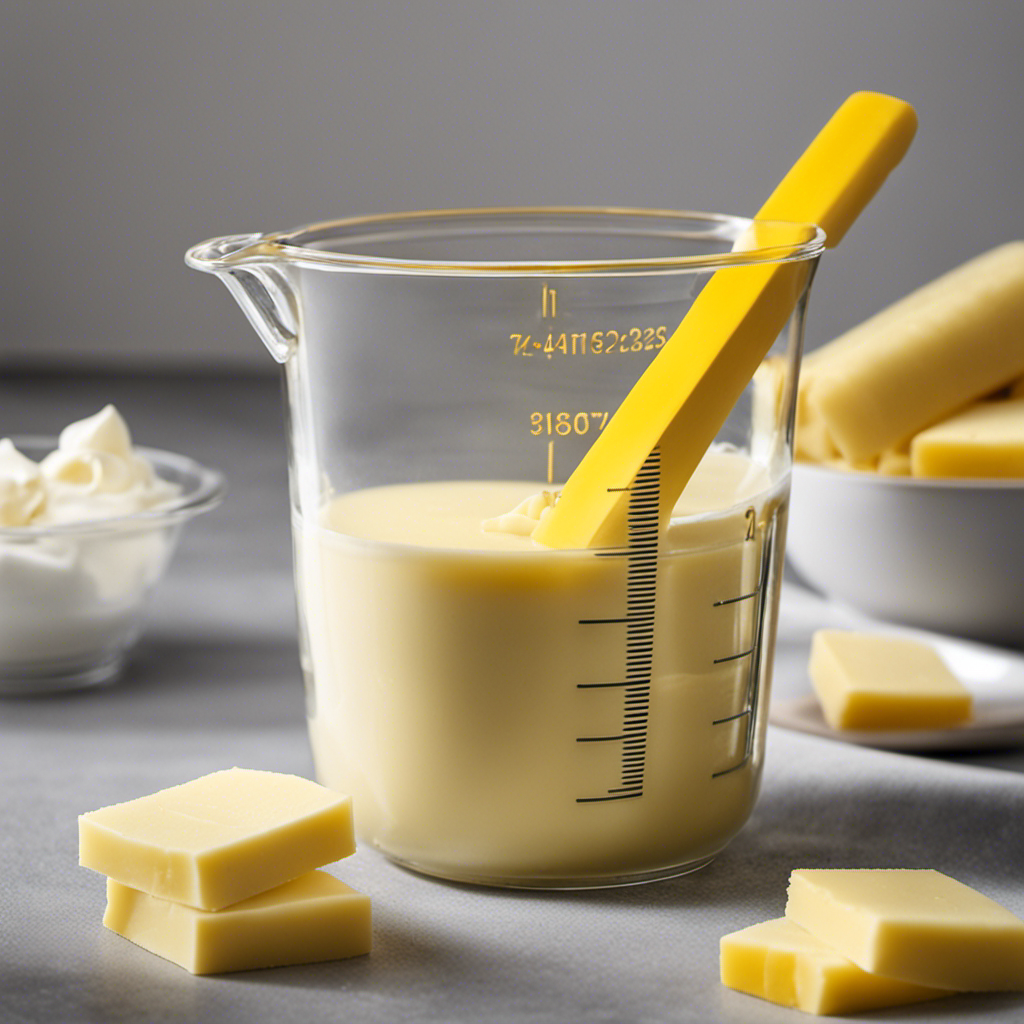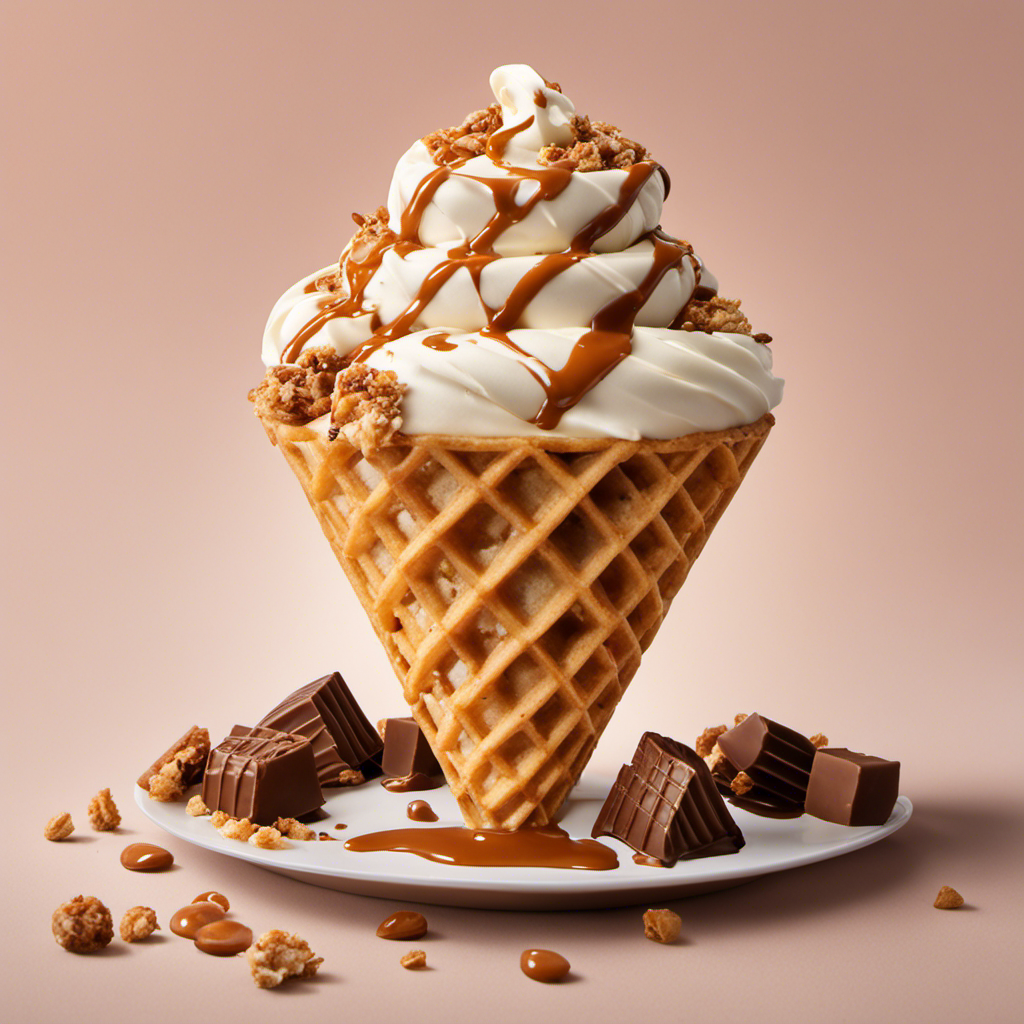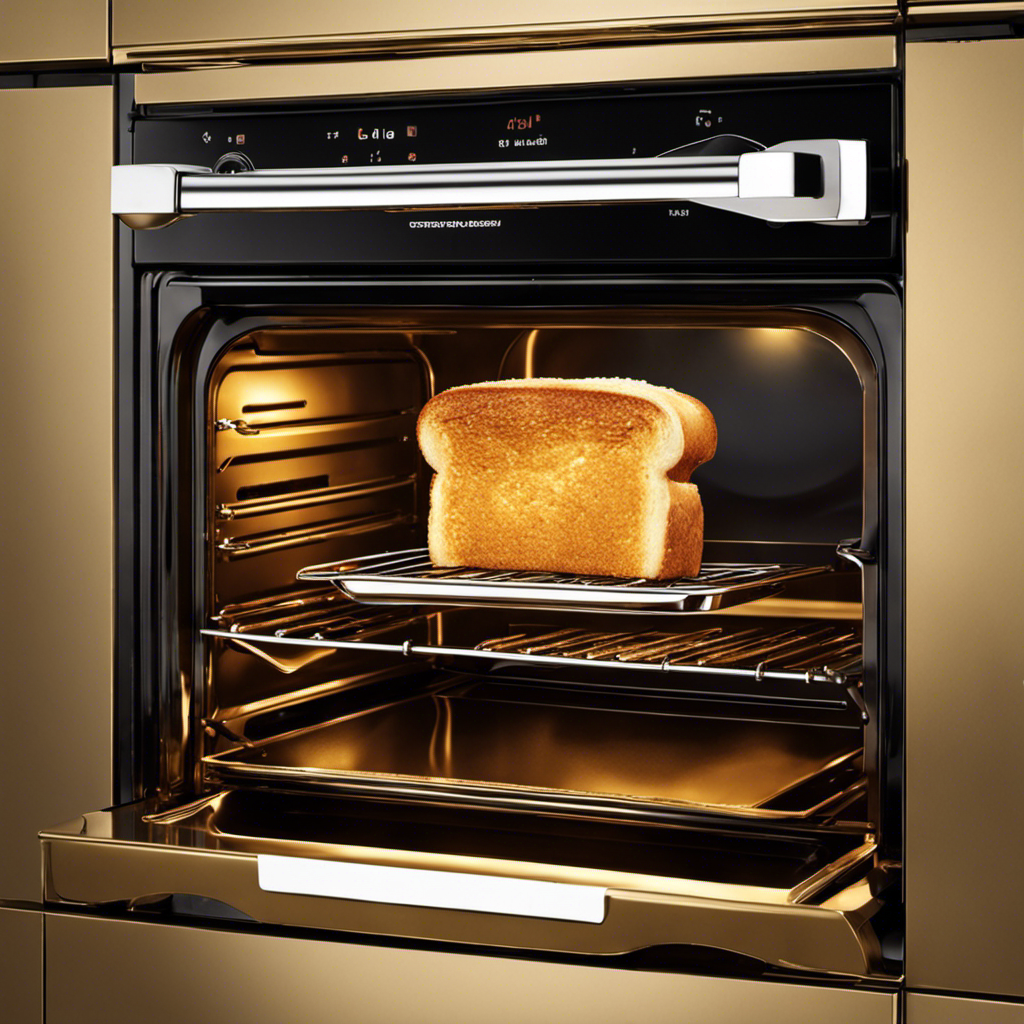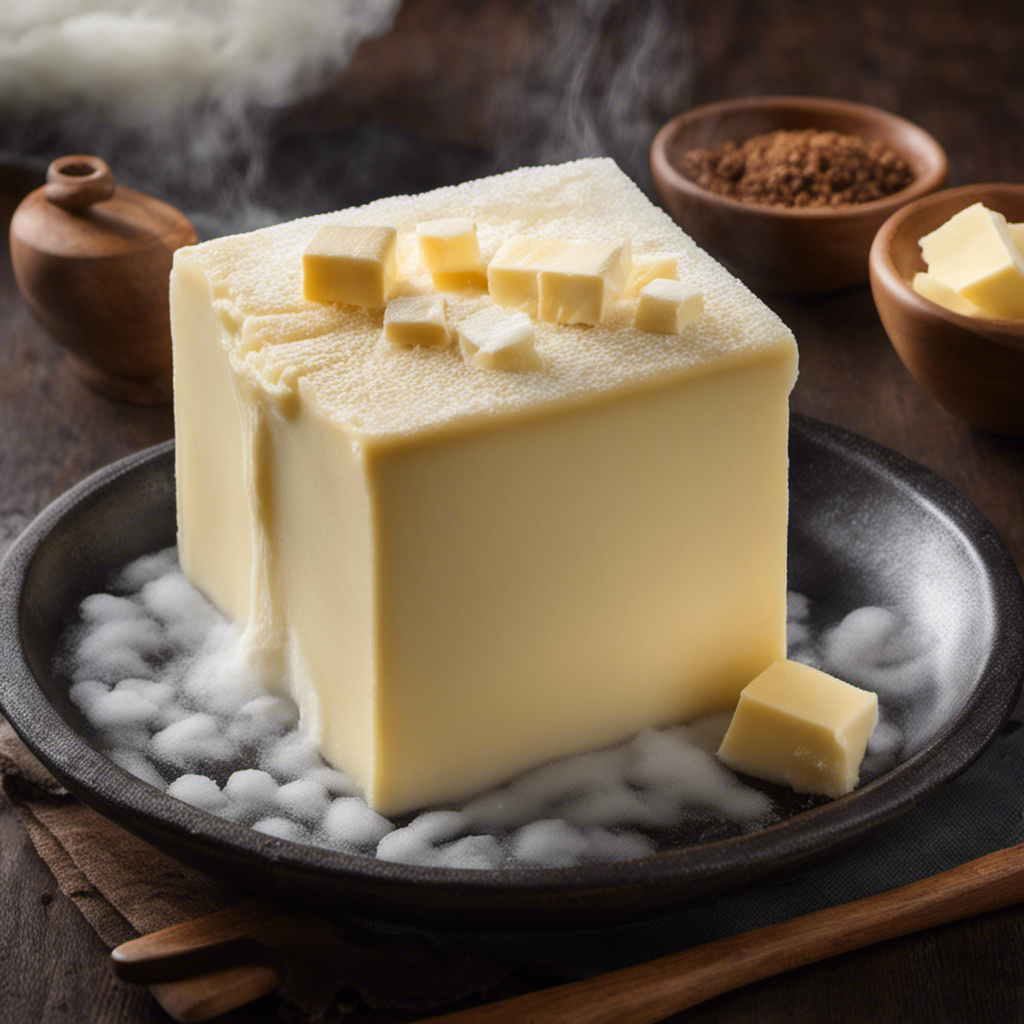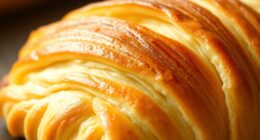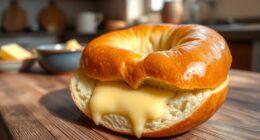I have a creamy secret to share with you – are you aware of the true amount of a quarter cup of butter? In this article, I will lead the way in demystifying this question, guaranteeing that your culinary creations are flawless on every occasion.
We’ll dive into understanding the measurement, explore conversion ratios, and even discuss substitutes in case you’re running low on butter.
So, let’s roll up our sleeves and get ready to measure some butter!
Key Takeaways
- A quarter cup of butter is equivalent to 4 tablespoons or 60 grams.
- Accurate measurements are crucial for consistent baking results.
- Butter is sold in sticks, tubs, or blocks.
- Butter substitutes such as coconut oil, Greek yogurt, and applesauce can be used in baking.
Understanding the Measurement
Understanding the measurement of a quarter cup of butter is important for accurate baking. When it comes to cooking and baking, precise measurements are crucial for achieving consistent results.
A quarter cup of butter is equivalent to 4 tablespoons or 60 grams. However, it’s essential to note that butter can vary in density, so using a scale to measure the grams may be more accurate.
To convert a recipe that requires a different amount of butter, you can use conversion techniques. For example, if a recipe calls for half a cup of butter, you can simply double the measurement of a quarter cup.
Measuring equivalents like these help ensure that you add the right amount of butter to your recipes, resulting in delicious and perfectly baked goods.
Conversion Ratios
To convert measurements, you’ll need to know the ratio between different units. When it comes to butter conversion, it’s important to understand how different measurements compare to each other.
Here are three common ratios for butter measurement:
- 1 stick of butter = 1/2 cup = 8 tablespoons
- 1/2 cup of butter = 1/4 pound = 1 stick
- 1 pound of butter = 4 sticks = 2 cups
These ratios are useful when you need to convert between different measurements of butter. For example, if a recipe calls for 1/2 cup of butter and you only have sticks of butter, you can use the first ratio to determine that you’ll need 1 stick. Understanding these conversions can make it easier to follow recipes and ensure accurate measurements.
Now that you know the ratios for butter conversion, let’s move on to discussing butter packaging sizes and how they affect measurements.
Butter Packaging Sizes
When it comes to butter packaging sizes, you’ll find that there are different options available for you to choose from. Butter is typically sold in sticks, tubs, or blocks.
Sticks are the most common option, with each stick usually measuring 1/2 cup or 1/4 pound (or 113 grams) of butter.
Tubs are another popular choice, offering convenience and ease of use. They come in various sizes, ranging from 8 ounces to 16 ounces.
Blocks, on the other hand, are larger and can be sliced or grated as needed. These packaging options make it easier to measure and use butter in recipes.
Whether you prefer sticks, tubs, or blocks, it’s important to use proper butter measurement techniques to ensure accurate results in your cooking and baking endeavors.
Importance of Accurate Measurements
When it comes to cooking and baking, recipe success relies heavily on accurate measurements. Whether it’s measuring out a cup of flour or adding a teaspoon of salt, precision is key. Accuracy ensures consistent results, allowing you to recreate your favorite dishes time and time again.
It’s also important to avoid ingredient substitution errors, as using the wrong ingredients or quantities can throw off the entire recipe. So, be sure to follow the measurements and instructions carefully for delicious and successful results every time.
Recipe Success Relies on Measurements
Make sure you accurately measure a quarter cup of butter for recipe success. Understanding conversions is crucial when it comes to cooking and baking. Here are three reasons why using butter in your recipes is beneficial:
-
Flavor: Butter adds richness and depth to dishes, enhancing their overall taste. It adds a creamy, savory element that can’t be replicated by other fats.
-
Texture: Butter provides moisture and structure to baked goods, resulting in a tender crumb and a melt-in-your-mouth texture. It also helps create flaky and golden crusts.
-
Browning: Butter has a low smoke point, which means it can be heated to high temperatures without burning. This allows for a beautiful golden-brown color on foods like roasted vegetables or seared meats.
Accurate measurements are vital because they ensure consistent results. Whether you’re baking a cake or making a sauce, precise measurements guarantee that your dish turns out as intended.
Accuracy Ensures Consistent Results
To ensure consistent results, it’s important to accurately measure your ingredients when cooking or baking. Understanding conversions and common butter measurements is crucial in achieving the desired outcome of your recipe.
When it comes to butter, there are various measurements that you may encounter, such as tablespoons, teaspoons, and cups. For example, a quarter cup of butter is equal to 4 tablespoons or 8 tablespoons. It’s important to accurately measure the butter using measuring spoons or a measuring cup specifically designed for liquids or solids.
By doing so, you can avoid ingredient substitution errors and ensure that your recipe turns out just right.
Now let’s discuss the importance of avoiding ingredient substitution errors to maintain the integrity of your dish.
Avoid Ingredient Substitution Errors
Accurately measuring ingredients is crucial in avoiding substitution errors and maintaining the integrity of your dish. To ensure you get the perfect measurement every time, here are three tips to avoid measurement errors and successfully substitute butter in your recipes:
-
Use a kitchen scale: Weighing ingredients is the most accurate way to measure them. This is especially important when substituting butter with alternatives like margarine or coconut oil, as their density can vary.
-
Read the recipe carefully: Double-check the measurement requirements and make sure you have the right amount of butter or substitute before you start cooking. A small error in measurement can significantly affect the taste and texture of your dish.
-
Follow conversion charts: If you’re substituting butter with a different ingredient, consult a reliable conversion chart to determine the appropriate amount. This will help you maintain the desired flavor and consistency in your recipes.
Recipes Using a Quarter Cup of Butter
When it comes to cooking, I love making flavorful dishes that are rich in buttery goodness. However, I understand that not everyone can or wants to consume butter. That’s why it’s great to know that there are butter substitutes available that can still give you that creamy taste without the dairy.
Additionally, when it comes to baking, sometimes you only need a small amount of butter. It’s important to know how to properly measure and incorporate that amount into your recipes to achieve the perfect balance of flavor and texture.
Flavorful Buttery Dishes
You can’t go wrong with adding a quarter cup of butter to your flavorful dishes. Butter has a rich and creamy taste that enhances the flavors of both sweet and savory recipes.
Here are three ways to incorporate butter into your cooking:
-
Buttery Desserts: From classic chocolate chip cookies to indulgent pound cakes, butter is a key ingredient in creating deliciously moist and tender desserts. Its buttery flavor adds depth and richness to every bite.
-
Savory Butter Sauces: Butter can be melted and used as a base for flavorful sauces. Whether you’re making a creamy béarnaise sauce or a tangy lemon butter sauce for seafood, the addition of butter adds a velvety texture and a luxurious taste.
-
Buttered Vegetables: A simple yet satisfying way to enjoy butter is by adding it to cooked vegetables. The melted butter coats the veggies, adding a rich and indulgent taste. Try it with roasted asparagus or sautéed mushrooms for a mouthwatering side dish.
In addition to butter, there are also various butter substitutes available that can be used in your recipes.
Butter Substitutes Available
There are several butter substitutes available that can be used in your recipes. These alternatives not only provide a different taste but also offer various health benefits. Here is a table displaying some popular butter substitutes and their unique qualities:
| Butter Substitute | Taste | Health Benefits |
|---|---|---|
| Coconut Oil | Slightly sweet and nutty | Boosts metabolism and supports heart health |
| Avocado | Creamy and mild | Rich in healthy fats and vitamins |
| Greek Yogurt | Tangy and creamy | High in protein and probiotics |
| Olive Oil | Light and fruity | Rich in monounsaturated fats and antioxidants |
| Applesauce | Sweet and fruity | Low in fat and calories, high in fiber |
As you can see, these butter alternatives not only add flavor to your dishes but also provide additional nutritional benefits. So, don’t hesitate to experiment with different substitutes in your recipes for a healthier and equally delicious outcome.
Baking With Small Amounts
When it comes to baking, precise measurements are crucial for achieving the perfect results. Understanding measurements is key to creating delicious treats.
One common measurement in baking is a quarter cup of butter. However, if you don’t have enough butter or prefer to use a butter substitute, there are a few options available. Here are three alternatives you can try:
-
Margarine: Margarine is a popular butter substitute that can be used in baking. It has a similar texture and flavor to butter, making it a suitable replacement in many recipes.
-
Coconut oil: Coconut oil is another great substitute for butter. It adds a subtle coconut flavor to your baked goods and can provide a moist and tender texture.
-
Applesauce: For a healthier alternative, you can use unsweetened applesauce instead of butter. It adds moisture to your recipe and can help reduce the fat content.
Experiment with these butter substitutes to find the one that works best for you and your taste preferences. Happy baking!
Substitutes for a Quarter Cup of Butter
One option for a substitute for a quarter cup of butter is using margarine. Margarine is a common alternative for baking and can be easily found in most grocery stores. However, if you are looking for healthier butter options, there are a few alternatives you can consider.
Here is a table showing some substitutes for baking and their benefits:
| Substitute | Benefits |
|---|---|
| Coconut oil | Contains healthy fats and adds a subtle coconut flavor to baked goods. |
| Greek yogurt | Low in fat and adds moisture to baked goods. |
| Applesauce | Low in fat and adds natural sweetness to baked goods. |
These alternatives not only provide a healthier option but also add unique flavors and textures to your baked goods. Experimenting with different substitutes can be a fun way to explore new flavors while still maintaining a healthier choice.
Tips for Properly Measuring Butter
To properly measure butter, it’s important to use a kitchen scale or the markings on the butter wrapper. This ensures accuracy in your recipes and helps you achieve the desired results.
Here are three tips for measuring butter effectively:
-
Use a kitchen scale: Weighing butter on a scale gives you the most accurate measurement. Simply place a container on the scale, set it to zero, and add the desired amount of butter until you reach the correct weight.
-
Understand conversions: If a recipe calls for a specific amount of butter in cups, but you only have sticks or tablespoons, it’s crucial to understand the conversion rates. For example, one stick of butter is equal to half a cup or eight tablespoons.
-
Consider using butter alternatives: If you’re looking to reduce your intake of saturated fats or have dietary restrictions, there are several butter alternatives available. Options like olive oil, coconut oil, or applesauce can be used as substitutes in recipes, but it’s important to understand how they may affect the texture and flavor of your dish.
Frequently Asked Questions
Can I Use Margarine Instead of Butter in Recipes That Call for a Quarter Cup of Butter?
Yes, you can use margarine as a substitute for butter in recipes that call for a quarter cup of butter. It will provide a similar texture and taste, but keep in mind that margarine has a higher water content.
How Can I Accurately Measure a Quarter Cup of Butter Without a Measuring Cup?
To accurately measure a quarter cup of butter without a measuring cup, you can use the markings on the butter wrapper. Alternatively, you can use a tablespoon and measure out 4 tablespoons of butter. Remember, butter substitutes may affect the taste and texture of your recipe.
Are There Any Dairy-Free Alternatives to Butter That Can Be Used in Recipes?
There are several dairy-free butter alternatives that can be used in recipes. Some popular options include vegan butter made from plant-based oils, such as coconut or avocado oil. These alternatives provide a similar taste and texture to traditional butter.
Can I Use Salted Butter Instead of Unsalted Butter in Recipes That Call for a Quarter Cup of Butter?
I can use salted butter instead of unsalted butter in recipes that call for a quarter cup of butter. However, I should reduce the amount of added salt in the recipe to account for the salt in the butter. There are also butter substitutes available for those who prefer dairy-free options.
What Is the Best Way to Store Leftover Butter After Using a Quarter Cup in a Recipe?
After using a quarter cup of butter, I usually store the leftovers in an airtight container in the fridge. If I run out of butter, I might use an alternative like margarine or coconut oil instead.
Conclusion
In conclusion, understanding measurements in cooking is essential for achieving precise and delicious results.
When it comes to butter, a quarter cup is equivalent to 4 tablespoons or 57 grams.
Interestingly, according to a study conducted by the U.S. Department of Agriculture, the average American consumes around 5.6 pounds of butter per year!
So next time you’re in the kitchen, remember the importance of accurate measurements and enjoy experimenting with different recipes using a quarter cup of butter.
Happy cooking!
